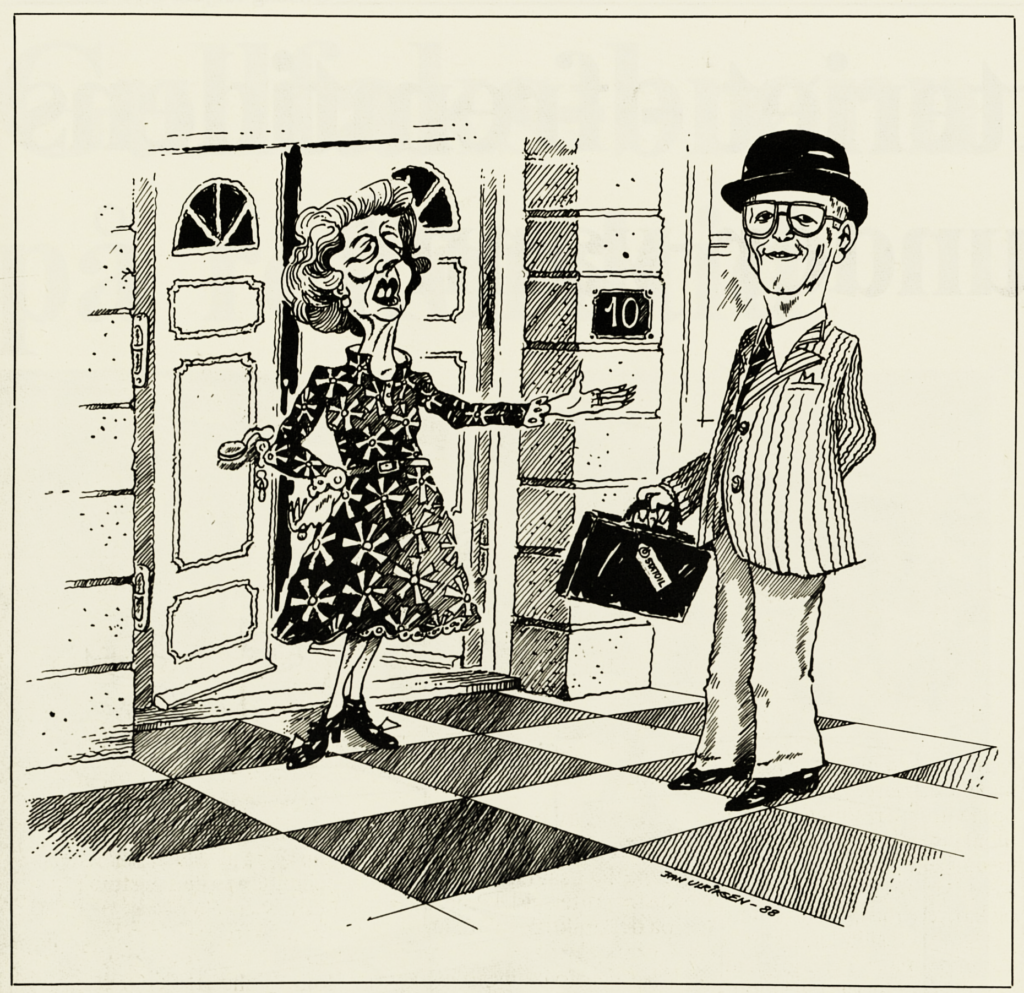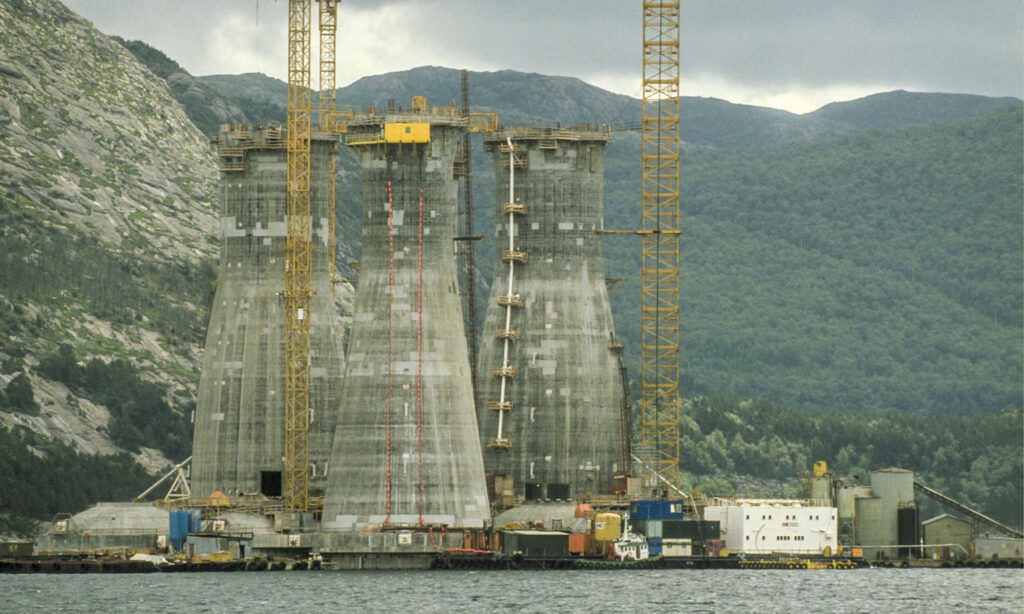Gas from Sleipner East to Europe

Gas was discovered in Sleipner East in 1981.[REMOVE]Fotnote: For a full account of drilling activity in the Sleipner area that year, see Annual report, 1981, Norwegian Petroleum Directorate, 1981: 32-33. That same year, the licensees with Statoil in the lead began talks with the state-owned British Gas Corporation on future deliveries to the UK.[REMOVE]Fotnote: Lerøen, Bjørn Vidar, 1996, Troll. Gas for generations. Shell: 72. A letter of intent was signed between the parties three years later.[REMOVE]Fotnote: Nerheim, Gunnar, 1996, En gassnasjon blir til, vol 2, Norsk oljehistorie, Norwegian Petroleum Society, Leseselskapet: 259.
But a basic proviso in the sales agreement was approval by the UK government. That was to prove a big challenge. The Conservative government under Margaret Thatcher was very negative to state monopolies, which left British Gas vulnerable. The relationship between its chair, Sir Denis Rooke, and the Thatcher administration is said to have been as strained as that between Statoil CEO Arve Johnsen and the Willoch government.[REMOVE]Fotnote: Ibid: 265.

An important consideration for Thatcher was that purchasing Norwegian gas would hinder the development of Britain’s own offshore resources. From such a perspective, big potential revenues and not least many UK jobs were at risk. The Statoil management recognised that the deal would not be approved by the British government, and the final rejection from London came in February 1985.[REMOVE]Fotnote: Board minutes, Statoil, item 4/84-4, 26 April 1984 (Source: SAST, Pa 1339 – Statoil ASA, A/Ab/Aba/L0002: Styremøteprotokoller, 26.01.1979 til 28.06.1985, 1979-1985).
From no to yes
With the UK out of the picture, a resolution was found during negotiations with buyers in western Europe on selling the gas in huge Troll field. Statoil’s management had become aware as early as the spring of 1985 that the latter was so attractive that it should also be possible to include other gas sources in an export agreement.[REMOVE]Fotnote: Board minutes, Statoil, item 4/85-2, 29 April 1985 (Source: SAST, Pa 1339 – Statoil ASA, A/Ab/Aba/L0002: Styremøteprotokoller, 26.01.1979 til 28.06.1985, 1979-1985). Even when a buyer’s market had developed, gas from Sleipner East could be incorporated in the final contract.
That solution also allowed the sellers to offer an earlier start to deliveries in the autumn of 1993.[REMOVE]Fotnote: For additional details about Sleipner East and the 1993 start-up year, see Annual report, 1993, Norwegian Petroleum Directorate: 53-54. If the agreement had been based on Troll alone, gas could not have started flowing until three years later. The fact that Statoil, leading the sales talks for the sellers in a difficult market, secured this early delivery date has been described as remarkable.[REMOVE]Fotnote: Lerøen, Bjørn Vidar, op.cit: 95.
For strategic reasons, it was especially important for Johnsen to increase the gas volumes sold to France via Belgium and thereby establish pipelines to destinations other than West Germany. That in turn would prevent Norway’s most important negotiating counterparty – a consortium headed by Ruhrgas – acquiring excessive bargaining power.
Johnsen’s strategy was to negotiate with France’s Elf (which was outside the consortium) over larger volumes than Gaz de France (in the consortium) was talking about. The latter quantities were not large enough to justify a pipeline bypassing West Germany.
Ultimately, Elf was compelled to abandon the talks by the French government, which wanted all Norwegian gas deliveries to pass via Gaz de France. But the negotiating initiative with a second French company was enough to push France’s order up to eight billion cubic metres per annum – making it possible to realise a new pipeline.[REMOVE]Fotnote: Ibid: 95.
The final agreement was signed with the Europeans in May 1986. Development of Troll and Sleipner was approved by the Storting (parliament) on 15 December that year.[REMOVE]Fotnote: Proceedings of the Storting, 15 December 1986: 1792-93. https://www.stortinget.no/no/Saker-og-publikasjoner/Stortingsforhandlinger/Lesevisning/?p=1986-87&paid=7&wid=a&psid=DIVL14&pgid=b_0368, accessed 26 April 2022. Most things looked bright after entering into the biggest export contract in Norwegian history.
Down and up again

Then came 23 August 1991 – one of the most difficult days in Statoil’s history.[REMOVE]Fotnote: See Lerøen, Bjørn Vidar, 2002, Drops of black gold. Statoil 1972-2002, Statoil: 213-218, and Sandberg, Finn Harald, The Sleipner sinking and Draugen. https://draugen.industriminne.no/en/2018/05/14/the-sleipner-sinking-and-draugen/, accessed 26 April 2022. On that fateful morning, the unthinkable happened – the gravity base structure (GBS) to support the Sleipner A platform sank to the bottom of the Gands Fjord off Stavanger. Virtually no other civilian construction has yielded a corresponding seismic reading on the Richter scale.
Fortunately, no lives were lost in a disaster caused by a design error.[REMOVE]Fotnote: Sandberg, Finn Harald, op.cit. See also Lerøen, Bjørn Vidar, 2020, Født til rikdom. En reise i Norges oljealder. Cappelen Damm: 323. But only just over two years remained until gas deliveries were due to start. Work on a replacement GBS had to start again from the beginning. Norway’s reputation as a reliable gas supplier had never been more under threat.
With the help of an extensive turnaround operation, Statoil succeeded in this effort. The Sleipner A platform was ready to deliver gas on the date specified in the Troll sales agreements.
Sleipner East proved a crucial test of Statoil’s organisation and for Norway as a gas nation. This field was at the heart of two of the biggest material crisis and strategic negotiating drama in Norwegian petroleum history. But it led to innovative negotiating solutions and a record catch-up operation.
arrow_backPioneering production in the northBolts from the bluearrow_forward